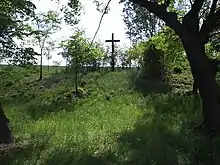Battle of Poniec
The Battle of Poniec took place on October 28, 1704 in Poniec, Poland, during the Great Northern War. The Swedish Army under Charles XII unsuccessfully dislodged the Saxon Army under Johann Matthias von der Schulenburg through several cavalry charges. The Saxons had deployed in a massive square formation near the village of Janiszewo, west of Poniec.
| Battle of Poniec | |||||||
|---|---|---|---|---|---|---|---|
| Part of the Great Northern War | |||||||
 Memorial to fallen Swedish soldiers near Poniec | |||||||
| |||||||
| Belligerents | |||||||
|
|
| ||||||
| Commanders and leaders | |||||||
| Charles XII | Johann Matthias von der Schulenburg | ||||||
| Strength | |||||||
| 2,700–5,600[1] | 5,500–6,000[1] | ||||||
| Casualties and losses | |||||||
| 400[2]–650[1] | 500–800[1] | ||||||
Background
In August 1704, Charles XII of Sweden marched to Lwów, Poland, which was taken after a brief siege. Augustus II the Strong, who camped in Sandomierz, took advantage of this by marching to Warsaw, where he occupied the city and captured 1,500 Swedes. When Charles XII returned to the city in October, Augustus II fell back to Kraków. General Schulenburg tried to cross the river Oder and flee to Saxony with 4,500–5,000 infantry and 1,000 cavalry, but these were chased by Charles XII, who with 5,600 cavalry pursued them to the city of Poniec on October 28.
The battle
Schulenberg had twelve battalions of infantry and four squadrons of cavalry, a total of 5,500–6,000 soldiers whom he was in a hurry to mobilize. He took position on a field in front of the village of Janiszewo west of Poniec. The Saxons' left wing was protected by Poniec and the right wing was protected by an impassable swamp. The center was protected by a ditch with a wagon fort behind it by which Schulenburg placed his cannons. Initially, Charles XII only had one cavalry and three dragoon regiments. Five additional regiments arrived progressively or could not reach the battlefield in time.
The battle began when the Swedes attacked the Saxon line, quickly chasing away the cavalry on each flank as well as two infantry battalions. To avoid disaster, Schulenburg ordered a retreat. Noticing this, the Swedes advanced to attack once more. Schulenburg, however, managed to form up his soldiers in a large square formation at Moraczewo, successfully repulsing the Swedish onslaught. As more Swedish regiments progressively arrived during the evening, the Swedes attacked again. The Saxons were attacked from all directions, and the Swedes concentrated on attacking the gaps in enemy lines. The Swedes broke up the Saxon division, but the Saxons answered this with their powerful musket volleys. With casualties mounting, and a fog developing in the full night, Charles XII decided to disengage and pull back to Poniec. This allowed the Saxons to successfully retreat from the battle.
Aftermath
Charles XII admitted to a loss of 289 men killed and wounded, while Defoe mentions 400–500 Swedish losses in his biography about the king. Schulenburg admitted to a loss of 489 men, also losing most of his guns. Damian Plowy, on the other hand, estimates a total loss of 550–650 Swedes, and 500–600 killed or wounded and 200 captured Saxons. Charles XII pursued Schulenburg to the Oder river and neutral Silesia, where the Saxon commander reached safety. The Swedish king then turned his attention towards some 1,200–2,000 fleeing Cossacks at Bełcz Wielki; all but a few hundred were annihilated in the following Battle of Oderbeltsch.
References
- L. Kling, Jr, Stephen; Plowy, Damian (1996). Great Northern War Compendium, volume 1: The Battle of Poniec (Punitz) 1704. St. Louis: THGC Publishing. pp. 177–178. ISBN 978-0-9964557-0-1.
- Defoe, Daniel (1720). The History of the Wars, of His Late Majesty Charles XII. King of Sweden. London. p. 118. OCLC 642660555.
"Northern Wars, Oskar Sjöström" (PDF). Archived from the original (PDF) on 2014-06-07. Retrieved 2014-06-05.